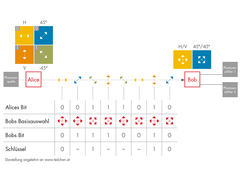How Quantum Cryptography Works
Application Fields for COUNT® Modules
Data security and data exchange are topics with increasing importance. How do you prevent data from being intercepted by a third party? The solution lies in cryptography: The message must be encoded. But what if the key exchange is intercepted? This is where quantum crytography comes into play.
The fundamental idea behind so-called quantum key distribution (QKD) is to use single photons instead of entire photon bundles. This way an eavesdropper (referred to as “Eve” in quantum mechanics) cannot simply divert the photons that are sent from Person A to Person B (referred to as “Alice” and “Bob,” respectively, in quantum mechanics). Eve would have to copy and then detect the photons to prevent the interception from being detected by Bob. This is precisely what quantum mechanics renders impossible (the so-called “no cloning theorem”).
Figure 1 depicts what key generation for coding and decoding data can look like. This so-called BB84 protocol (developed by Bennett and Brassard in 1984) uses the polarization of photons as a means of generating a key sequence. Alice selects one of four polarization states – H (horizontal), V (vertical), +45°, and -45° – and sends such a photon to Bob. She must first indicate which bit value the two orthogonally arranged polarization states have: 0 or 1. In our example, H corresponds to 0, V corresponds to 1, 45° correspond to 0, and -45° correspond to 1. If Bob receives such a photon, he decides whether to measure based on H/V or 45°/-45° and ultimately makes a note of the polarization state (and thus the bit value) of the photon. Bob communicates with Alice in the classic sense, and they compare their base selection. This information, which is of no use to Eve because she does not know the exact results, is sufficient for Alice and Bob to determine which bit values they can use for their key1.
A further development of the BB84 protocol uses entangled photons, which strongly correlate in their properties, that are sent from a single source to Alice and Bob simultaneously. One such source was developed, for example, by experimental physicists in Prof. Weihs’ photonics group at the University of Innsbruck: a pulsed Sagnac source of polarization-entangled photons2. Here a nonlinear crystal is used that produces two lower-energy photons at a wavelength of 808 nm from a higher-energy photon at 404 nm. The photons are detected using two “COUNT” SPADs by LASER COMPONENTS.
As secure as these methods are in theory, in practice there is a lot of room for error. The most significant sources of error are the single photon detectors that Alice and Bob use. In theory, the available detectors are perfect, identical, and have a detection efficiency of 100%; however, in practice, this is never the case. It is precisely this discrepancy in the detection efficiency of two detectors that quantum hackers use to access the key3.
An alternative method “blinds” the SPADs with the help of a light pulse and uses the “blind time” of the detector to intercept information4.
Thanks to the identification of sources of error by quantum hackers, research groups have been able to work on approaches for solutions to these problems and develop a “measurement unit-independent” version of the QKD5. The industry can also contribute to making the methods more efficient and precise. The constant exchange between research and industry is thus extremely important.
Secure Communication in Government Organizations
With QuNET, a project was initiated by the Federal Ministry of Education and Research (BMBF) in May 2019 in which a pilot network for quantum communication is being developed and set up in Germany. The goal of this project is secure communication in governmental and administrative agencies, in which every attempt at interception is safely detected. Research in quantum technology is already at the international forefront. In this legislative period, the federal government is providing 650 million euros for further expansion.
Datasheet:
Further product information:
Single Photon Counting Modules
Manufacturer:
LASER COMPONENTS Germany / Photon Counting
Contact:
| Contact Person: | Dr. Olga Stroh-Vasenev |
| Company: | Laser Components Germany GmbH |
| Address: | Werner-von-Siemens-Str. 15 |
| ZIP / City: | 82140 Olching |
| Phone: | +49 (0) 8142 2864-48 |
| Fax: | +49 (0) 8142 2864-11 |
| Email: | olga.stroh-vasenev@lasercomponents.com |
| |
|
























































